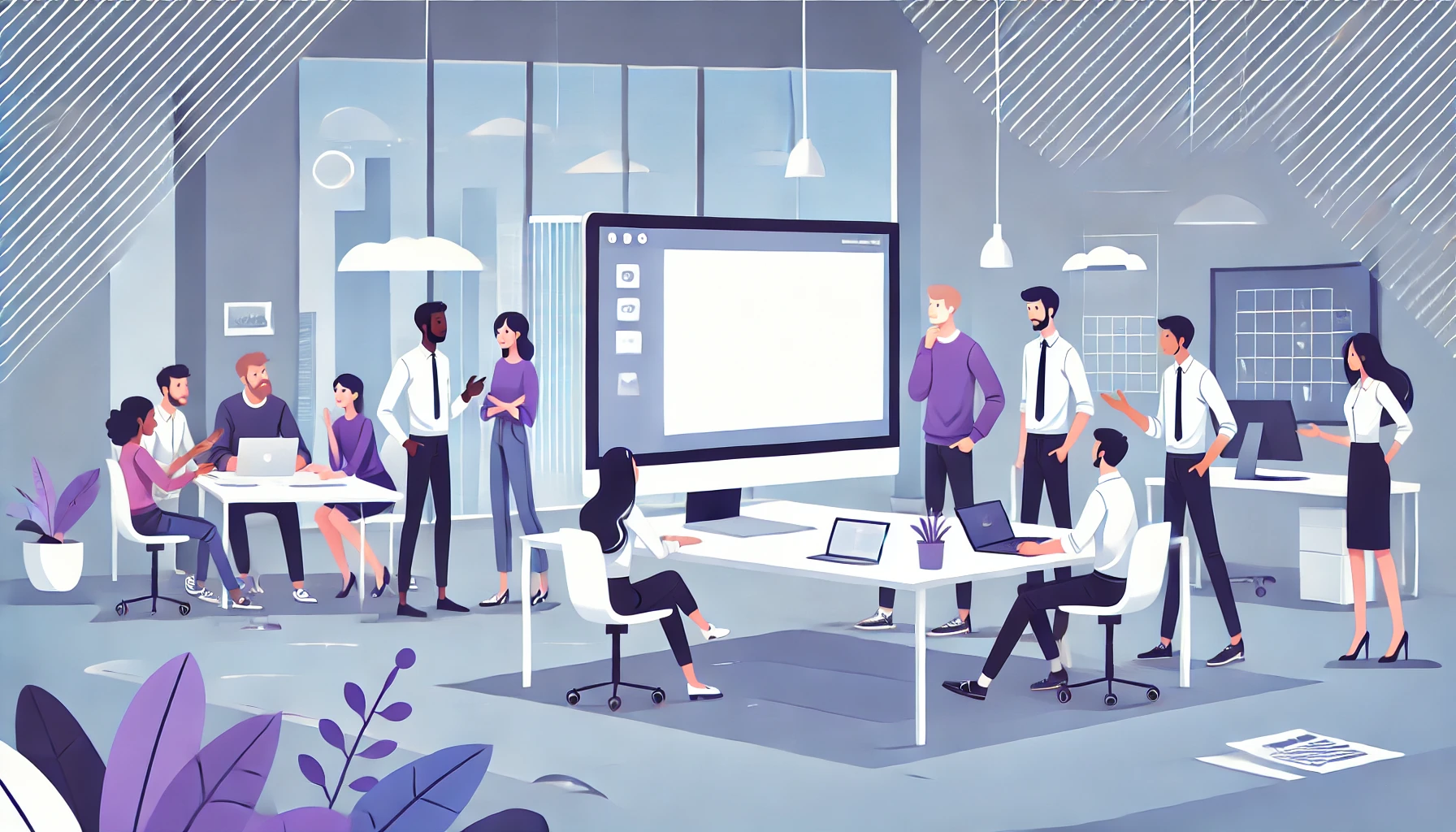
Create AI videos with 230+ avatars in 140+ languages.
A healthy funnel of home buyers is the bread and butter of any good real estate professional or home seller.
And 2023, no one can deny the power of video to draw in viewers and generate needs. 📹
Real estate marketing videos are a helpful tool in your sales arsenal.
They help you:
- Find more potential buyers
- Reduce the number of in-person viewings you need to do
- Provide a memorable reminder for buyers to take home to their families
This article will show you how to make a real estate marketing video without breaking the bank and what's important when staging a home for video.
What is a real estate marketing video?
Real estate video marketing is using promotional video content to promote your listings and the services your business offers.
Recent data from the real estate industry shows that an online search is the first step home buyers take to find a property.
And most of that online activity isn't direct face-to-face interaction — 47% of potential buyers started the search on the internet. In contrast, only 18% of buyers first contacted a real estate agent.
Video is a great way to bridge the gap between that online search and the power of a friendly face. It's a tool you can use to advertise yourself and your home.
A short video can:
- Help people find your listing more easily
- Work around the clock to attract buyers; it's an open house around the clock!
- Create buzz on social media platforms
- Provide buyers with more comprehensive information compared to printed pamphlets
- Create an instant visual connection with buyers looking for their dream home
- Attract tech-savvy millennials and gen Z, who have a higher purchasing power
Whether it's a video that details a property's features, a specific neighborhood, or your various services, videos are one of the best ways to attract new clients.
5 essential types of marketing videos that you can create
#1. Virtual tours of your property
Property listings with a video appeal to prospective buyers because they show more than just a floor plan — they make the floor plan come to life.
A virtual tour or walkthrough video should take potential buyers through every nook and cranny of the home. Many local buyers enjoy video walkthroughs, and buyers from different states or countries find them especially helpful.
Check out this example of a virtual walkthrough:
👉 Benefits of creating property videos:
- A home's "feel" is more easily understood in a video than in a photo.
- Buyers can see the whole picture, nothing is hidden or left out.
- With the right music and emphasizing the unique selling points, you can emotionally engage the viewer.
- It's great for buyers who can't physically view the home, such as a spouse whose out of the country.
- A listing video often results in viewing requests from people who are more likely to buy.
#2: Neighborhood video tours
A video tour walks buyers through the surrounding area, highlighting points of interest like schools and grocery shops. 🏘 It typically helps someone understand the benefits of a location and is especially helpful if your buyer is from another state or country.
👉 Benefits of neighborhood video tours:
- They place the property in the context of the location.
- You can establish yourself as an authority in the area.
#3. Client testimonials
A client testimonial video is the digital version of good ol' word of mouth. Your previous customers (buyers or sellers) record a video of themself talking about their experience working with you. Client testimonials provide great social proof that you have what it takes to get the job done.
👉 Benefits of sharing client testimonial videos:
- It adds credibility to your claims of sales targets.
- The customer's video can be used on your website.
- It's easy for your customers to record a video using their phones.
#4. Introduction videos
An introduction video is used to introduce real estate agents to potential clients. It gives a relatable overview of who you are, your business's operations, and your previous sales.
👉 Benefits of making introduction videos:
- Clients will feel more comfortable knowing more about you as a person.
- An introduction video will go a long way toward building trust.
#5. Educational videos
An educational video is one of the best real estate videos to establish your reputation in the industry. It can be anything from a quick video explaining common mistakes you see sellers making to promo videos that cover why a particular area is up and coming.
👉 Benefits of making educational videos:
- You can build influence with a library of videos for your YouTube channel.
- It's quick to share educational content in settings such as Facebook live.
- You create a more personal connection with your audience.
6 steps to making a real estate marketing video
Here's the good news: to make your real estate video, you don't need any prior video editing experience or expensive equipment.
Digital tools like Synthesia make it easy to create a real estate marketing video you can be proud of.
💡 When recording a video, remember these tips:
- Clean the lens to get rid of any lint or streaks.
- Level your camera or phone with a tripod. A handheld gimbal can help you to stabilize moving shots.
- Film in landscape (unless you're doing vertical videos as well).
- Use the zoom function sparingly. Most cameras have digital zoom, but it never looks as good as the original footage.
Step 1: Plan your shots
Walk through the home and plan what rooms and details you want to cover. Write down a shot list to ensure you don't leave anything out.
💡 Look at the different camera angles. You want to place your camera where:
- You can pick up the most detail.
- The space is easily understood in terms of space and relation to the furniture.
- The natural light works in your favor.
Treat your real estate video as a journey for the potential buyer. A quick and easy way to do it is to walk through the house like you usually would with new clients.
Step 2: Stage the home for your video
There's a good reason why we are drawn to homes on glossy magazine pages or reality shows like Selling Sunset. The homes are sparkly clean and appeal to a wide variety of people.

Decluttering is essential when you make a real estate video. It will make the home look more organized and spacious.
With less clutter, the potential buyer can respond emotionally to the space. They can start envisioning how their items will fit into the room.
Areas to pay attention to when decluttering a home for your video:
- Living area: Minimize photos, personal items, and knick-knacks and organize the bookshelf.
- Bathroom: Toilet seat down and remove private bath and shower items.
- Kitchen: clear the countertops, clean the oven and stove, and remove any dirty dishes and fridge magnets.
- Bedrooms: Remove wrinkles from bedspreads, minimize personal items, and tidy bedside tables.
- Study: Remove paperwork, unnecessary desk items, and power cables, organize the bookshelf and turn off monitors.
- Exterior: Remove trash and toys, clean the pool, and wash the windows.
Step 3: Shoot footage of the home's exterior and interior
The scene is set, you've got your shot list, and the home is camera-ready.
💡 Camera position tip:
You want to give the viewer an eye-level experience — not too low or high — to draw them into your property walkthrough. Keep the camera steady and use a tripod.
💡 Lighting tip:
Never underestimate the power of natural light. When you shoot inside, the windows essentially become your light source. But there's no one-size-fits-all.
So.. how to capture a home's best side?
- Capitalize on the sun's bright light and aim for 2 to 3 hours after sunrise and 2 to 3 hours before sunset. Times will change if a mountain or another house blocks the sun.
- The light source should always be at your back. Shooting into the light will create silhouettes and less detail.
- If it's too bright, you can soften the light by using light-colored and thin curtains.
- Lamps with a warm light can light up darker spaces like stairways. Be wary of LED lights as the color temperature tends to have a blue (cold) tint.
- If the light source is insufficient, try using a reflector to bounce light into the room.
When you shoot outside, avoid doing it at noon when you’ll see plenty of sharp shadows. Wait for golden hour, just before the sun goes down, and use the light as a backlight (behind you) to light up your subject.
💡 Composition tips:
Frame your shot with the rule of thirds: The rule of thirds is a composition technique. And in real estate, it can also indicate space. Imagine an empty tic-tac-toe box. You have three vertical columns and three horizontal rows. The rule states that the main elements should be positioned along the gridlines. And if you can, at the intersection of the gridlines.

Take a bedroom, for example. Instead of having the bed (the key element) in the middle, it should be towards the left or right and more towards the bottom.
How to pan your camera: Move the camera slowly and steadily from left to right and then again from right to left (this gives you more options for editing). Do it at the same speed when sweeping around the scene.
Step 4: Edit your footage together using a video maker
Now it's time to enhance the viewer's experience, convey important information, and give context to the footage.
👉 Start by adding title slides for each room. Indicate whether it's the main bedroom or living room, for example.
👉 Add text or a voiceover to highlight the unique features of each space. Focus primarily on what can't be communicated through your video, such as:
- The actual size of the room.
- Unique fixtures or fittings.
- Materials of floors or countertops.
- Included utilities.
- Area information such as distances to schools, malls, etc.
- Listing price.
- Property size: exterior, interior, and total square footage.
- Street address.
👉 Finally, add a call to action. Provide your name, contact number, and website address.
Step 5: Give it a personal touch with a visual presenter and voiceover
We understand that hiring an actor for videos is only sometimes possible.
Or you don't want to feature in the video yourself. 🙈
Luckily there is a hassle-free way to add a presenter to your video.
Using an AI video maker like Synthesia, you can create a video using real actors.
Within minutes your real estate video can feature one of the 70+ actors — or rather avatars — that are available. There are different ages, ethnicities, and styles to choose from.
Once you've chosen your presenter, it is time to add voiceover.
With Synthesia's text-to-speech tool, there is no need to record a voiceover.
You write your script, copy and paste it into the script box, and then it is generated into a voiceover! And there are more than 200 voices to choose from.
Step 6: Upload your video to your website, property sites, social media, and YouTube
That's a wrap on editing your real estate marketing video; now you can share it.
Using Synthesia, you can embed the video directly onto your website.
And if you ever want to make changes to an existing video, there's no need to embed it again, as it updates automatically.
Alternatively, uploading videos to YouTube is free for anyone. Like Synthesia, YouTube videos can be shared with the HTML code or link.
Ready for more buyers to contact you about your properties?
From adding an avatar and professional voiceover to using templates to ensure your video stays true to your corporate identity, Synthesia can help you transform the vision you have for a video into a reality. Create your first AI video for free today.
About the author
Strategic Advisor
Kevin Alster
Kevin Alster heads up the learning team at Synthesia. He is focused on building Synthesia Academy and helping people figure out how to use generative AI videos in enterprise. His journey in the tech industry is driven by a decade-long experience in the education sector and various roles where he uses emerging technology to augment communication and creativity through video. He has been developing enterprise and branded learning solutions in organizations such as General Assembly, The School of The New York Times, and Sotheby's Institute of Art.














